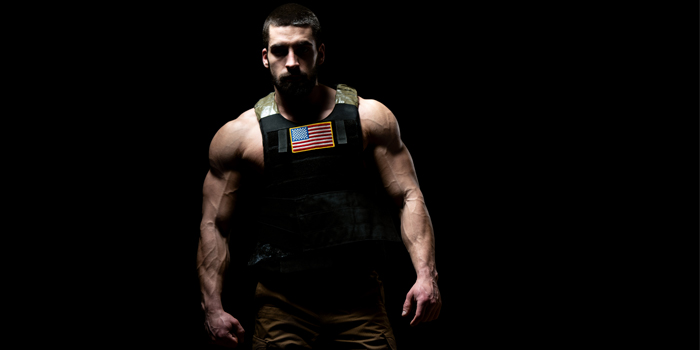
Let's talk tactical.
First off, what is "Tactical Strength and Conditioning (TSAC)," and how does it differ from a perhaps more traditional strength and conditioning program?
To answer, TSAC is simply the training of physical qualities for the tactical population, with the "tactical" population meaning military, fire, police, EMTs, or other first responders. Additionally, TSAC could be applied to those individuals who are not part of an organized body such as those listed but seek to train in a more rigorous and challenging manner. However, for the purposes of this article, we will be limiting the application of TSAC to those individuals within the defined tactical population. TSAC is very similar to other forms of strength and conditioning. It seeks to consider the specific needs and demands of a target population and create training protocols designed to meet and satisfy those demands. However, unlike strength and conditioning for athletic populations, which often require only one or two definitive qualities, TSAC often involves a multitude of needs and demands, requiring a broader and more thorough approach.
MORE: 3 Conditioning Methods to Use With Conjugate
To clarify, let's examine the demands of a sprinter—to be an effective and successful sprinter, one must possess great acceleration, top-end speed, and speed endurance and the capacities to both produce a high degree of force and at a high rate. There are obviously technical aspects that go into the making of a great sprinter, but those are often outside the domain of a strength and conditioning coach, and as such, will be left alone. In contrast, let's examine the demands of a tactical operator, perhaps an infantryman—to be a physically effective soldier, an infantryman must possess a high level of aerobic and anaerobic endurance, speed/power, strength, and overall agility.
Again, there are technical aspects of being a soldier that is not within the purview of a TSAC Facilitator (TSAC-F) that will be left alone in this discussion. However, the contrast is clear—the demands of a sprinter are, for lack of a better term, linear and straightforward, and while perhaps not easy to attain, are relatively simple in their training. On the other hand, a soldier requires a greater breadth of traits and characteristics to be successful on the battlefield. Thus, a soldier needs a more thorough approach to physical development via training.
As stated above, TSAC is not limited exclusively to the military—first responders (fire, police, and EMTs) are also considered "tactical" and should train in such a way that addresses the demands of their specific roles/duties. While these specific demands might vary from job to job, such as the demands of a firefighter versus the demands of a police officer, how these demands are trained are relatively the same.
Enter the Conjugate Method
Let's very briefly review the core principles of the conjugate method:
- Four-day split: Max Effort (ME) Lower, ME Upper, Dynamic Effort (DE) Lower, DE Upper
- Rotation of main movements for ME work
- Three-week waves for DE work
- Use of accommodating resistance (bands and chains)
- Systematic approach to identifying and addressing weak points
- High volume accessory/GPP work
- Simultaneous approach to training physical traits and characteristics
Without going into great detail about the basic, fundamental aspects of the conjugate method (this information can be found elsewhere on elitefts), we can immediately see that the conjugate method effectively addresses the demands of the tactical population.
Max Effort Method
The conjugate method utilizes max effort training, which stands as one of the most effective and efficient means of developing maximal strength—the foundation for all other strength qualities. While not the end-all-be-all of the tactical population, it should still be given a high degree of attention and adherence. Within the tactical space, maximal strength comes into play during events such as carrying or lifting, whether an object or a person, as well as the capacity to carry gear/kit into duty. More often than not, especially within the fire and military fields, operators carry or wear gear into duty or combat, much of which is heavy and bulky. The stronger someone is, the more effectively they will operate while under load. A weaker individual will have a greater degree of difficulty operating under load, thus rendering them a liability in the line of duty or within the context of team-based operations.
It should be noted that, by definition, the ME method is training to a 1RM, which, again, is the most effective means of training maximal strength. Although a powerlifter may depend highly on their absolute maximal strength, a tactical operator might rely less on their capacity to produce maximal force over a single exertion. Instead, a tactical operator may rely more on their ability to produce maximal force across multiple bouts of exertion. As such, they would undoubtedly benefit from the inclusion of 2, 3, 4, or 5RM training in conjunction/rotation with true 1RM training.
Exercise selection within the use of the ME method should reflect the population's relative training age/experience level—less experienced populations will require less variation. In contrast, more experienced populations will require more variation. The decision to include or exclude a certain variation, whether it's a specialty bar or accommodating resistance, comes down to the TSAC-F/coach and should be an informed decision based not only on experience levels but also available equipment time and available space.
Dynamic Effort Method
Whereas the ME method is useful for developing maximal strength, the dynamic effort (DE) method is useful for developing explosiveness and power, both of which are valuable within the context of TSAC training. However, the utilization of the DE method within the context of the tactical population must be such that it is geared toward the development of duty-specific qualities. Think explosiveness, power, and general anaerobic conditioning, rather than bar speed, as in a powerlifting context. I feel the DE method is well-suited for the development of the above listed qualities, and while other means exist and can be considered appropriate, proper utilization and implementation of the DE method will result in increased power output, explosiveness, and by keeping rest intervals short, overall conditioning.
As with the ME method, the DE Method falls into a number of pre-determined set/rep schemes, such as 12x2, 8x3, or 5x5. The selection of the most appropriate set/rep scheme falls to the TSAC-F/coach, and should closely reflect the specific demands of the population.
In combat, a soldier might have to repeatedly sprint or bound from cover to cover with minimal time to recover between exertions, and as such, might benefit more from a 5x5 scheme (more time under tension per set/exertion) versus a 12x2 scheme (less time under tension per set/exertion), whereas a SWAT team member entering a breached door might benefit from the speed and explosiveness of a 12x2 scheme. Arguments for and against each and every scheme can be made, and no one is more right or wrong—again, it comes down to the specific demands of the population or role, and determining the most effective means of addressing those demands.
Repetiton Effort Method
Finally, the repetition effort (RE) method, which forms the foundation of the conjugate method, finds itself well-suited to the tactical population. In powerlifting, the RE method is often used as a means to develop hypertrophy/general strength/GPP, with the end goal of increasing the weight on the bar for the main lifts. Within the tactical space, where maximal weight is not the end goal, the RE method becomes a way to address physical weaknesses and improve overall conditioning/durability rather than the overall weight. In other words, RE method work within the tactical space is intended to improve overall function and resilience. Ultimately, it'll reduce the likelihood of musculoskeletal (MSK) injuries in the line of duty or during training.
The RE Method can be applied across a wide breadth of set/rep/volume schemes, each of which must be reflective of the demands of the role or the specific phase of training. High-volume training (15-20+ reps) is traditionally used for developing endurance, whether aerobic/anaerobic/local muscular, as well as the development of connective tissue hypertrophy. In contrast, lower-volume work (6-10 reps) is traditionally associated with the development of general strength and muscular hypertrophy. Again, the means by which the RE Method is implemented are not set in stone and must be modified as needed to satisfy specific demands.
RE method exercise selection is, as with the ME and DE Methods, specific to the population's needs. Most tactical populations will require similar things (upper back/shoulder health, lower back durability, knee/ankle stabilization) based on common themes across the population. However, how these demands are met (free weight vs. bands, as an example) comes down to the same set of parameters as the ME method (experience level, available equipment, space, etc.).
Conclusion
The conjugate method is well-suited to the demands of the tactical population. By training multiple strength/physical qualities at the same time, or in sequence, the conjugate method covers all the bases when it comes to the physical development of the tactical operator/athlete, and can create a well-streamlined system of training that essentially runs itself. The conjugate method, on paper, can seem daunting and complicated, and it absolutely can be but does not need to be. Any coach or facilitator can easily run it with a competent understanding of the method's basic tenets. So, for those of you looking to develop a comprehensive and effective means of training, whether as a coach or operator, give the conjugate method a try—you might just be surprised at the results.
Header image credit: jalephoto © 123rf.com
Jim Seratt is a Strength and Conditioning Coach contracted with the United States Army. He has served as a strength and conditioning coach for ten years, operating in the private, collegiate, and professional arenas before working with the Army. He is a self-published author, podcaster, and multi-ply powerlifter in the 242/275 weight classes. He can be reached at jseratt.cscs@gmail.com or on Instagram at @jimberjacked.











2 Comments